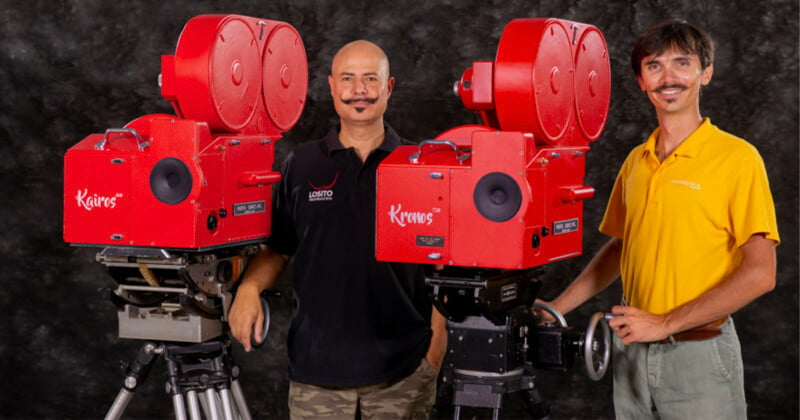These 65mm Motion Picture Film Cameras Can Shoot 720 Frames Per Second

A pair of motion picture film enthusiasts have created the world’s fastest, large format 65mm cameras by converting old recording technology that was used by the military to film atomic bomb tests.
Max Losito and Luca Bonicalza spent a year tinkering with old Photo-Sonics 70mm cameras to create the Kairos 360 and Kronos 720. Kairos has a frame size of 20.47 x 23.03 inches (52 x 58.5 mm) and shoots 90, 180, or 360 frames per second. While Kronos has a frame size of 20.47 x 1.12 inches (52 x 28.5 mm) with speeds of 180, 360, and 720 frames per second.
“It was a very long process that involved a lot of skill in different areas: from designing parts to precise mechanisms, optics, and just the knowledge of the original slow-motion cameras,” Losito tells PetaPixel.
The pair had to think “outside of the box” to solve the many problems they encountered while making Kairos and Kronos but their passion for the old technology and knowledge of the fine mechanics within spurred them on.
“It was very difficult to get a complete set of operational [Photo-Sonics cameras] and in good condition,” explains Losito. “Some of these camera bodies had been left out day and night in airforce bases. The weather was for sure brutal to them.”
70mm Photo-Sonics cameras were made to capture extremely detailed, high-quality footage primarily for the purposes of science rather than art. They were used by the military to record atomic bomb tests in the Pacific.
Thanks to Lostio and Bonicalza’s project, the Kairos and Kronos are now not only the world’s fastest 65mm film cameras — but faster than any digital camera in the same format.
“This is actually a very big innovation, as cinema has never been working with high-speed 65mm,” says Losito.
“Today, there are few productions that bringing people to cinemas and these movies are mainly shot on big formats.
“We wanted to take part in this revolution giving bigger chances to artist to perform their vision with high-speed shooting since we do believe that a movie is something that has to be lived collectively.”
Losito and Bonicalza say cinematographers and directors will be attracted to the quality of the cameras in terms of color, resolution, and depth of field which is held even at the maximum frame rate.
“We can see explosions, we can imagine the use in VFX made by the top directors and DPs who really need to take advantage of shooting amazing effects with a quality that was not available before,” adds Losito.
According to British Cinematographer, the cameras are available to productions wanting to test them at Losito International Films studio and the cameras are available to rent in the U.S. and Europe.